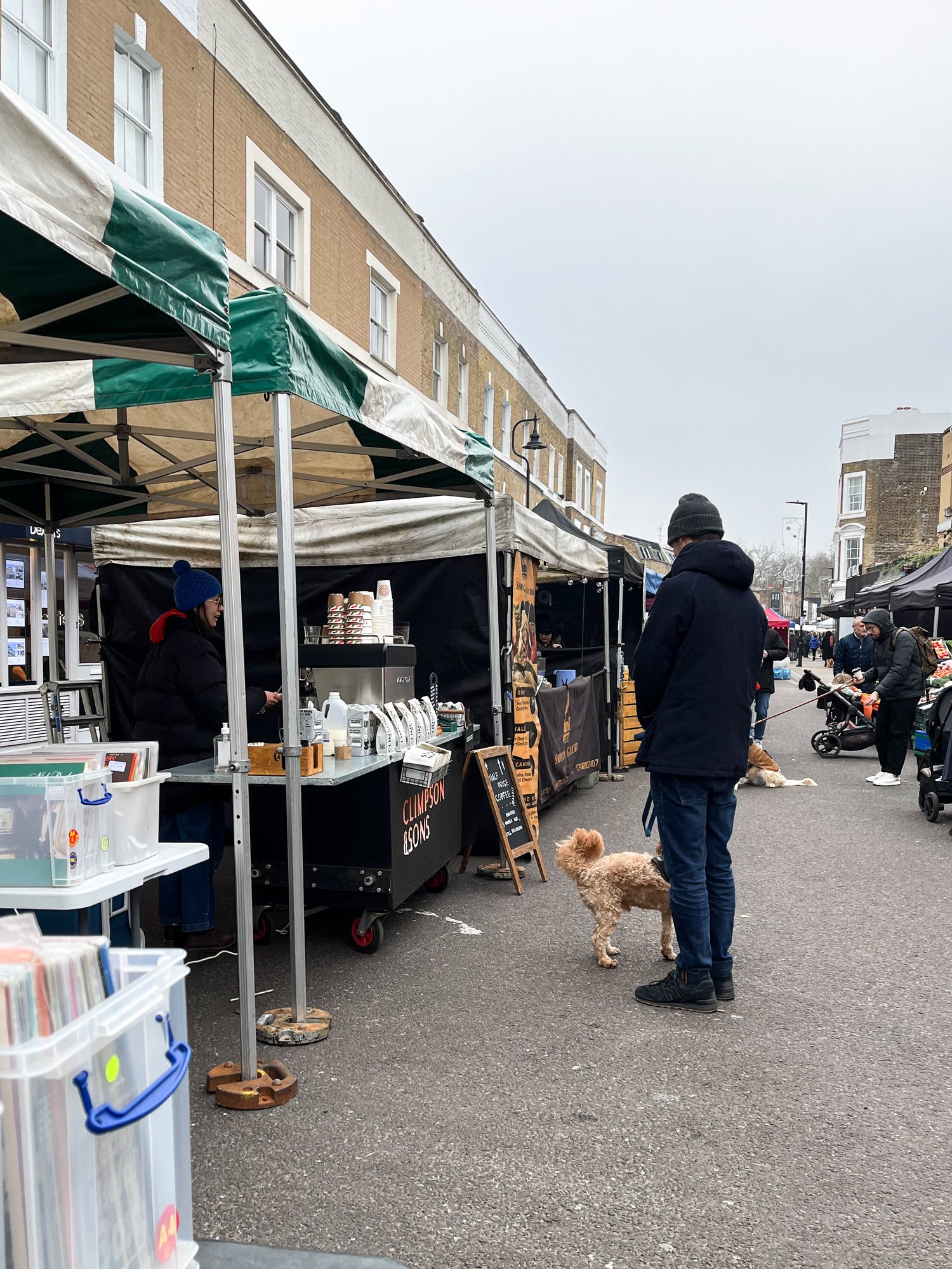This year we celebrate 20 years of Climpson & Sons. Beginning as a market stall all those years ago, we take a look at where it started, and what’s changed in the street scene over the last two decades.
Food markets are a staple of the weekend routine for most Londoners and provide a great day out for the weekly influx of tourists from all over the world. These markets have a varied history, some having existed for centuries and others appearing in the last few decades. Their offering as varied as their beginnings, London’s markets range from the traditional farmer’s offering of veggies and meat from nearby growers, to a more contemporary offering of independent producers and street food operators. Here we look at how these markets have evolved since Climpsons first started brewing on the street scene back in 2002.

Market life is certainly integral to Climpson’s history, with Ian’s initial ambition being to improve the coffee offering in UK markets. Before taking residency in East London, he ran stalls at both Chiswick and Barnes Farmers Market, as well as brewing up in one of the UK’s oldest outdoor markets in his homeland of Norwich. Bringing quality coffee to the people, he purchased traceable specialty coffees, increasing the average cup price of a coffee from 60p to £1.50 (... the market stall is still going strong as Little Red Roaster to this day). For the last 20 years our market stall on Broadway has set up every Saturday, excluding a brief lockdown hiatus. We’ve also since made our home under the historic roof of Old Spitalfields Market as part of a new development in 2018 that brought ‘The Kitchens’ to E2 - a collection of street food offerings to feed the Monday to Friday city worker and entertain the East London tourists on the weekends. We’re market people, through and through.
Evidence of food markets in the city trace back to Roman Londinium where most of the population didn’t have access to a kitchen. The menu itself is unconfirmed, however archaeological excavations often include a fair few oyster shells, suggesting the people were partial to a streetside oyster. Almost 2000 years later, you can still slurp a curbside oyster from our Broadway neighbours Fin and Flounder.
Fast forward to the unprecedented population boom of the Victorian era. The rise of industry meant a hungry and low-paid workforce, in need of cheap, fast and wholesome fare and lacking the space and facilities to cook at home. The Dictionary of Victorian London sets the scene here.
“Two of the condiments greatly relished by the labourers and others who regale themselves on street luxuries, are "pea-soup" and "hot eels." Of these tradesmen there may be 500 now in the streets on a Saturday. These dealers are stationary, having stalls or stands in the street, and the savoury odour from them attracts more hungry-looking gazers and longers than does a cook-shop window. They seldom move about, but generally frequent the same place.”
London saw a flavourful shift in its food offering after waves of immigration following two world wars. Culinary tastes began to reflect a multicultural urban population with the adoption of street food cuisines from across the world. This wide ranging choice of flavours, ingredients and producers makes the brilliantly diverse food scene we enjoy in London’s markets today. Our global neighbours in Old Spitalfields Market include Cafe Caribbean, Dumpling Shack, Merkamo Ethiopian and The Pleasant Lady. It’s a long way from hot eels and we’re glad for it.

Later in this century, we see a great shift in the coffee industry. You may have heard this time described as a ‘Third Wave’. An initial surge of coffee drinkers began in the 1960s as beans became commercially accessible for home consumption in the UK. This followed with a second wave, as larger companies began their expansions, shifting the perception of the drink as coffee became a luxury product to be consumed outside the home. From here, a third wave formed, as consumers searched for a higher quality product that was fairly traded, traceable and with an emphasis on sustainability. Here we also see the introduction of lighter roast profiles, more precise filter brewing methods and the chase for delicate complexities in the cup. Not just restricted to the coffee nerd, these tastes gradually become commonplace as more and more people become used to the profiles of specialty coffee.
Climpsons truly surfed this third wave of specialty coffee, noticing a distinct lack of decent coffee across London’s food markets. At markets, consumers had the opportunity to shop directly from the people who had grown their food. Here, families were shopping for quality fruit, vegetables and meats to cook an organic weekend feast, but the quality of coffee was still lagging behind, most often coming from factory-style roasteries, producing for volume rather than flavour. Climpson & Sons founder Ian saw an opportunity to bring the values of traceability and thoughtfully prepared consumables to market shoppers by making a well sourced and well executed cup of coffee.
This was the start of something, and we saw specialty coffee and the slow food movement rise hand in hand over the next two decades. Broadway Market continues to provide a ripe offering of fruits and vegetables from farms such as Wild Country Organics in nearby Cambridgeshire as well as traceable and naturally reared meats from Downland Produce. Alongside the more traditional farmers market stalls, we also see a great offering of street eats. Stroll along the street on any Saturday and you can buy yourself a quality meal from a number of brilliant, established street food vendors. Here we see the provision of the food market come full circle, catering to the busy city dweller on the move, who may lack the space and provision to cook from their inevitable urban flat share.
The popularity of street food has seen its expansion into more established and permanent ventures. As well as The Kitchens of Old Spitalfields Market we’ve also seen countless other food halls opening across the UK including the Arcade Food Hall on Oxford Street, Seven Dials by Kerb and Mackie Mayor in Manchester. Needless to say, specialty coffee is always on offer here, and quite often these spaces give an opportunity for coffee-startups to find their feet without huge overheads, or perhaps providing the place for more established businesses to reach new customers. Often these ventures also make use of would-be-empty retail spaces crumbled by the pandemic. A food market certainly brings a whole lot of life to an abandoned retail unit.
So what happens next? Le Cordon Bleu lays out some predictions for our street food markets of the future. They suggest that as well as the rise of multi premise food halls, we can expect to see an increased variety in offerings, given the relatively low start up costs of a street food vendor allowing for experimentation and creativity. They also predict more prestigious cooks will take their offerings to the street, alongside established bricks and mortar ventures, as any snobbery against ‘street food’ is well and truly wiped away.

While there’s an undoubtable convenience to the street food we love, there is also a slight sadness to communal dining here. As each individual in the group chooses their own dinner, there’s a lost joy in the togetherness of a shared sit down meal, guided by a knowledgeable and skilled waiting team. The emphasis is on dining with speed, as street food venues are set up to serve at volume, a quick turnaround at a shared table encourages diners to shovel quickly, or perhaps squeeze a standing lunch into a half hour break. In addition to this, the throwaway culture from disposable packaging, compostable or not, feels in stark contradiction to the ethics of sustainability so many of us now live our lives by. I can’t help but feel there might be an oncoming quiet revolution of the sit down meal, as consumers choose to spend their shrinking disposable income on a less frequent, but truly special and curated dining experience, served on ceramic as opposed to single use vegware.
However the street food market is no doubt here to stay in some form in the UK, having existed to some degree in our cities across centuries. We’ve seen great shifts in the quality of produce offered over the years, including specialty coffee becoming commonplace in a market setting after Climpsons pioneering vision 20 years ago. We’ve also seen offerings shift from traditional fare to a wide ranging profile of flavours cooked to perfection by our country's diverse population. It’s a joy to live in a borough like Hackney, where a Saturday stroll can end in a curbside Argentinian steak, a Vietnamese banh mi or a German bratwurst, as well as picking up a bag of locally grown veggies to take home for dinner, all whilst sipping a Climpsons espresso fairly traded from our long-standing producer friends in Brazil. It’s been a pleasure to be a feature of Broadway Market evolving street offering for 20 years. Here’s to the next 20.



